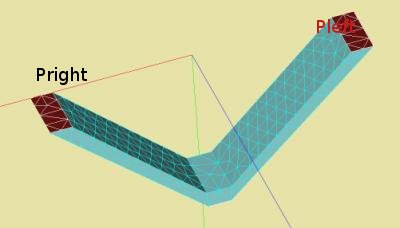Difference between revisions of "Contrib:KeesWouters/plasticity"
Keeswouters (Talk | contribs) (→'''Non linear material properties''') |
Keeswouters (Talk | contribs) (→'''Non linear material properties''') |
||
| Line 37: | Line 37: | ||
: [[image:Kw_sigma_eps_steel.png]] | : [[image:Kw_sigma_eps_steel.png]] | ||
| − | The plastic material behaviour is defined by TRACTTION and a table of (eps_i - sigma_i) | + | The plastic material behaviour is defined by TRACTTION and a table of (eps_i - sigma_i), as indicated in the figure. In the keyword DEFI_MATERIAU apart from Young's modulus and poisson ratio, now TRACTION is given for the non linear (eps-sigma) relation. The command AFFE_MATERIAU assigns the material to the complete mesh. |
#Material properties | #Material properties | ||
Revision as of 15:48, 12 August 2009
V shaped construction under plastic deformation
The V shaped is defined by an extrusion of a V shaped face.
Three planes are defined in the geometry: Pleft and Pright for applyind boundary conditions (dx=dy=dz=0) and Pforce for defining a prescribed displacement in y direction.
The definition of the geometry as well as the meshing is given in the Python input file.
In the geometry module of Salome select File --> Load Script (or ctrl T) and thereafter the file: Media:kw_gm_vshape.zip.
General procedure of the calculation
The general procedure of the calculation is as follows:
- read the mesh
- apply the non linear material properties of the construction
- define the boundary conditions
- define the maximum load, in this case a maximum displacement at the plane Pforce
- define 'time' and 'load' increments:
- the time is defined from 0.0 to 2.1 and stepsize 0.1 s, yielding 21 points.
- The load multiplication factor is defined by ramping from 0.0 to 1.0 during the first 1 s,
- then keep it constant at 1.0 for 0.1 s and
- decreasing from 1.0 to 0.0 in the last second.
- perform the analysis
- define results in a med-file for Salome, in this case, displacements, vonMises and plastic stresses
- print results in a file, notably the displacements of the plane Pforce and its corresponding forces.
In the figure the results of four load cycles are given: the maximum displacement of each calculation is 0.080, 0.085, 0.095 and 0.100 mm. The plastic deformation at a load free construction after the load cycle is roughly 0.005, 0.009, 0.018 and 0.022 mm.
Each dot in the curves indicate a output point of the calculation. In most case 21 points are given, these have been defined in the 'time' increment function.
Non linear material properties
The linear material behaviour of steel is defined by the Young's modulus E = 210 GPa.
The plastic material behaviour is defined by TRACTTION and a table of (eps_i - sigma_i), as indicated in the figure. In the keyword DEFI_MATERIAU apart from Young's modulus and poisson ratio, now TRACTION is given for the non linear (eps-sigma) relation. The command AFFE_MATERIAU assigns the material to the complete mesh.
#Material properties
Traction=DEFI_FONCTION(NOM_PARA='EPSI',
VALE=(1.6e-3,300.0,
2.0e-2,400.0,
1.0e-1,450.0,
1.5e-1,473.0,
2.0e-1,500.0,
3.0e-1,550.0,),
INTERPOL='LIN',
PROL_DROITE='LINEAIRE',
PROL_GAUCHE='EXCLU',);
#define plastic behaviour of steel by Traction
steel=DEFI_MATERIAU(ELAS=_F(E=2.1e5,NU=0.27,),
TRACTION=_F(SIGM=Traction,),);
#assign material steel to the whole construction matprops=AFFE_MATERIAU(MAILLAGE=pmesh,AFFE=_F(TOUT='OUI',MATER=steel,),);



